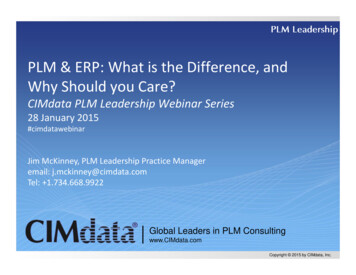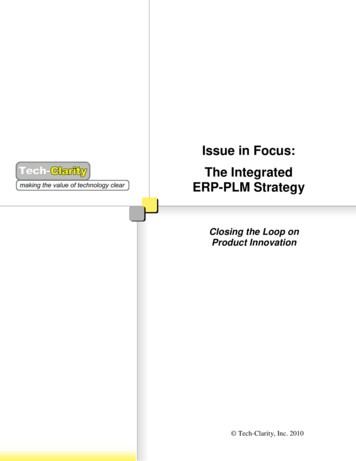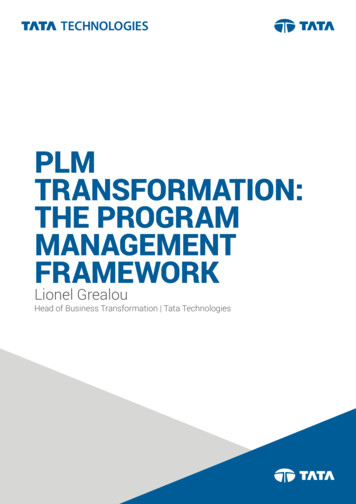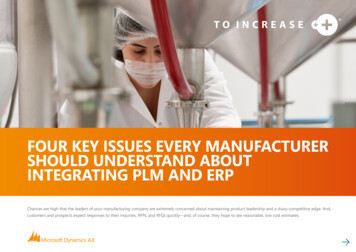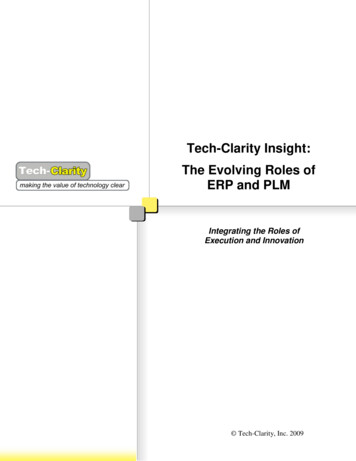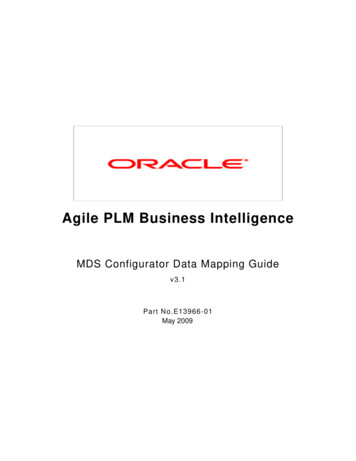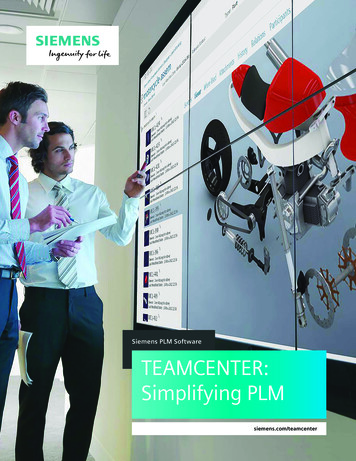
Transcription
PLM to ERP Integration – Impact to ManufacturingDassault Systemes: 3DEXPERIENCE FORUM Nov. 2014Presenter name: Bryan HansonPresenter Title: PLM Technologist @ Medtronic Inc.
PLM to ERP Integration – Impact to ManufacturingWelcomeIntroductionMedtronic OverviewPLM - ERP
THAT’S MORE THAN 10 MILLION PEOPLE.
v
THE MEDTRONIC MISSIONto contribute to human welfare byapplication of biomedical engineering to
27,000 PATENTS AND COUNTING40 MEDICAL CONDITIONS5,600SCIENTISTS ANDENGINEERS
Spinal Conditions andMusculoskeletal TraumaCardiovascularDiseaseCardiac RhythmDisordersEar, Nose and ThroatConditionsNeurologicalDisordersUrological and DigestiveConditionsDiabetes
ADDRESSING THE NEEDS AND CHANGINGHEALTHCARE FOR THE BETTERIMPROVE CLINICALOUTCOMESOPTIMIZE COST ANDEFFICIENCYEXPAND ACCESS
“Across the world, we are in a continuousquest to improve healthcare.People everywhere want better outcomes We’re developing medical technologiesthat not only improve healthcare, but do sowhile delivering better economic value.”
PLM to ERP Integration – Impact to ManufacturingTODAYS LECTUREIntegrating from a PLM system to an ERP system impacts themanufacturing process with almost liveintegrations. Controlling the flow of data will avoid negativeimpact to ERP/MES systems for design changes, allow forERP data setup, and manufacturing changes to becontrolled.Lessons learned from Engineering BOM changes at aproductions status to controlling that change with the MCOprocess.
ERP Integration HistoryMedtronic has had ERP Integrations 20 years20 Years ago Medtronic had two main business units:NeurologicalCardiac Rhythm Management.The PLM system at that time was SherpaSherpa was integrated to JDE using flat file being sent to a FTP sitewhere JDE would “process” the data. Basic Item and BOM data.2003-4 Sherpa was retired for MatrixOne.ERP/JDE was updated to use XML InterfaceSAP Added to the ERP Integrations2008 – MatrixOne upgrade to EnoviaERP Interface Redesign for SAP and Enovia XBOM (Mfg BOM)
B4 2008 and Enovia XBOMBetween 2003 & 2008, parts in Enovia underwent a number of lifecycle changes(Unreleased, In Review, Released, Obsolete) and design status (Conceptual,Development, Pre-Production, Production) changes.Pre-ProductionDevelopmentDESIGN STATUSProductionConceptualNew Item or RevisionUnreleasedIn ReviewReleasedObsolete“Conceptual” status is available for early design work.“Development” status is required to make prototype build units.“Pre-Production” status is required to make design verification and manufacturingprocess build units (Getting FDA Qualified).“Production” status is required for human implants (clinical or market release).
ERP Integration History Lessons LearnedThe MatrixOne interface from 2003 had the followingproblems: No Effectivity date control on production level BOMsR&D Restricted in new component revisions bymanufacturing.Shotgun change to ERP and MES systems.Shotgun?
ECR/ECO Change Process ImpactEngineering releases an ECOEng.ReleaseNo Control of DataShotgun changeto all facilitiesManually ControlledParts ES) Medtronic’s ERP systems require Mfg facilities be identified at design for cost, supplychain and Mfg planning. The facilities are specified on the Engineering BOM. Engineering changes were immediately communicated upon ECO approval. Target systems can choose to accept the parts by filtering the data at the WebMethodslevel or business rules at the target system.Note: WebMethods is Medtronic's Enterprise Applications Integration layer.
Four YearsBetween 2004 and 2008 Medtronic's manufacturing facilitieson SAP had to implement a special team to prepare andreview ALL ECO changes that impacted them.These special teams:Cost TimeCost PeopleSlowed down the processLarger manufacturing facilities were moving to SAP, theydemanded an improvement to the interface.30
Enovia V6R2010 Engineering and XBOM CentralThe 2008 Redesign Focused on: Design a PLM & ERP integration, which enables theeffective synchronization between the engineering bill ofmaterial (BOM) and the manufacturing bill of material. Streamline the engineering and manufacturing change orderprocess. Effective Date from PLM Free R&D to perform engineering changes withoutimpacting manufacturing operations. SAP had no QueueWhat's a Queue?
A Queue Holds the data for processingProgramMain/ApplicationTableThis gives ERP controlManufacturing (MES) always wants to control when manufacturing data is updated.All Records stored in Staging Table (Staging Table is part of ERP functionality)Record sequencing is done in Staging TableProcessing/ Transaction Logic is in ERP/Pre-processing ProgramUser Interface to select and apply Enovia DataCustom error handling is built in pre-processing programNo automatic email Notification
Feeding the QueueControl the Design Changes:Enovia XBOM withManufacturing ChangeOrder n/ApplicationTableMCO generation per plant from ECO. This allows Plants tocontrol data flow. Engineering Changes will no longerimmediately affect production.Can use MCO rather than ECR/ECO to push out plantimplementation date
MCO Change Process -Impact onPreProduction & ProductionEngineering releases an ECO with design changes. Each Manufacturing facilitycan now control their change.ECOProcessMCO-1 for Med-RelMCO CoordinatorImplement MCO-1 for Med-RelMCO-2 for EOCMCO CoordinatorImplement MCO-2 for EOCMCO-3 for SMOMCO CoordinatorImplement MCO-3 for SMOWhen the ECO is released, each facility specified on its parts will have an MCO generated.The MCO will contain a MBOM which is a copy of the EBOMThe MCO Coordinator will control the EBOM change to the ERP MBOM through the MCO.Design and Manufacturing have separated their processes and now each control theirchanges through the system without impacting each other.
ECO/MCO Workflow – Yellow Integration Points
Design ChangesECO or MCO will determine BOM Usage in SAPEngineering version of Production BOM will exist in Enovia (System of Record) User can update PRTs in SAP BOMPartial BOM creation will not be allowedBOM status will be active in SAPUser will compare BOM in Enovia prior to releasing to SAPUsers can set different BOM Release date to SAP specific their Plant in EnoviaPart Status:Conceptual/DevelopmentStatus Changes toPre-productionProductionEBOMAssign TemplateAssign GFS R/C CodeBOM ComparisonMBOMs are Plant Specific. Users will compare the BOM for theirsite prior to releasing the BOM into SAPMBOM
2008 V6R2010 Interface ScopeThe interface will only handle creation requests of Raw Materials (ROH), Semi-FinishedGoods (HALB), Bulk Materials (FHMI), Non-Stock Items (ZLNG), and OperatingSupplies (HIBE).End Items/Package Assemblies (ZFRT) are NOT in scope.The requested materials: will be unique in SAP will only have ‘Basic Data 1’ and ‘Basic Data 2’ view created will have Cross-plant Material Status of ’10’ (i.e., Item Setup)The description of requested materials will have maximum of 40 characters.Enovia design status is stored in internal comment in SAP for information purpose only.The maximum Base Character for a given Base Number is ‘Z’.The maximum Base Tab for a give Base Number is ‘999’.The cross reference tables (i.e., UOM, part sub-type, etc) must be maintained manually.The master data (i.e., Base Character and Base Tab) must be maintained manuallyperiodically.BOMs will be created at Active status.
Enovia – Universal BridgeDesign ModuleECO ProcessXBOM ModuleMCO ProcessDesignItem & DatabaseAdapterAdapter Enovia supports a common PLM Interface to ALLERP and MES systems. ECO Process communicates Design BOM(Conceptual and Development status)Factory Works (Multiple sites)JDECOMPASServer The Enovia Interface targets multiple systemssending the same data through a single interface.SAP MCO Process communicates ManufacturingDesign intent (PreProduction and Production) perfacility, with facility control of the data flow.SAP (V6) and JDE both support an Interfacedesigned to accept Item and BOM Informationfrom multiple sources. Supports a CommonPLM Strategy
SAP Queue – Red Light/Green Light39
Challenges We FaceAssemblies that are Manufactured or Purchased:MDT owns the design thus dictates the BOMcomponents to the suppliers. PLM needs to define theBOM, but ERP doesn’t want the BOM because they don’ttransact on the components. CMCO used to add Manufacturing Responsibility(MR). Problem is that component revs will generatean unwanted MBOM. Manufacturing switches from buy to make. NeedsMBOM. IT has to clear MR/MBOM. Business readds MR to generate MBOM.40
Crazy Train – Cascading Manufacturing ResponsibilityWhen implementing a Manufacturing BOM to an existingPLM system with an existing ERP integration, it would benice if the system gave you a button to Generate theMBOM. Business does not always want a Change Orderto generate a MBOM that already exists in ERP.Adding MR to an Assembly causes MR to be added to thecomponents, all the way to the bottom of the BOM. This“cascade” can result in humongous MCOs. MDTcontrolled this by making every Assembly an End Item.Need a better way.Group Add Manufacturing Responsibility41
THANK YOUwww.medtronic.com 2013 Medtronic, Inc.
PLM to ERP Integration – Impact to Manufacturing
Design a PLM & ERP integration, which enables the effective synchronization between the engineering bill of material (BOM) and the manufacturing bill of material. Streamline the engineering and manufacturing change order process. Effective Date from PLM Free R&D to perform engineering changes without impacting manufacturing .


